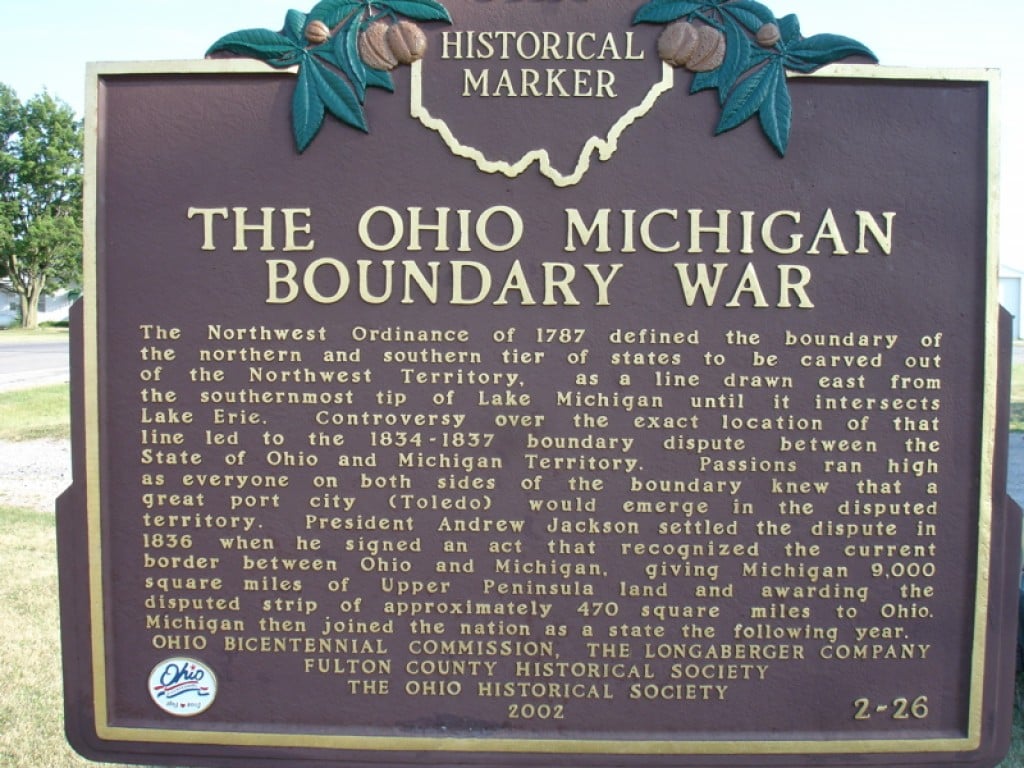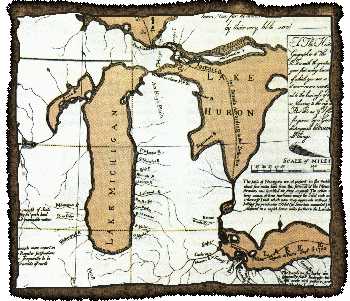
In 1835, Michigan and Ohio were at “war” with each other over a disputed part of land, called the Toledo Strip. Toledo was a very important trade hub, due to its location, and both sides wanted control of the city. The outcome of this little “war” would ultimately benefit both sides, but not before some blood was inevitably shed.

The reason for the dispute was due to inaccurate mapping of the Michigan territory at the time, when Ohio was officially a state, but Michigan was not. In 1787, the Northwest Ordinance was enacted, which described the boundary line between Ohio and Michigan as being an east-to-west line originating from the most southern point of Lake Michigan. (1) However, when more accurate mapping was done, it was found that if the Ordinance was updated to the correct mappings, Ohio would effectively lose most of its cities on Lake Erie, so Ohio drew a diagonal line to try and keep some of the valuable land. When Michigan applied for statehood in 1833, they used the definition that the Northwest Ordinance gave, which created a small strip of land (about 7 miles wide) that was now disputed between the two states. It just so happened that the important city of Toledo was in this strip. (2)
Naturally, both sides felt as if they were entitled to the land, and felt as if they were being imposed upon. Ohio’s Governor Lucas mobilized 600 militiamen and stationed them in Perrysburg, Ohio, just before Michigan’s Governor Mason occupied Toledo with about 1,000 men. While no actual fighting broke out immediately, both sides squabbled with petty things like vandalism and petty arrests.
The Battle of Phillips Corners
The only real “battle” of the Toledo War was called the Battle of Phillips Corners, in which the Michigan militia ambushed an Ohio surveyor team, capturing several of them. The Ohioans who escaped claimed that the Michigan forces fired at them, but the Michigan militia denied the accusations, saying they only fired their guns into the air. Although nobody was even hurt, the event only resulted in both sides being even madder at each other.
The Summer of 1835
As anger flared in both Michigan and Ohio, both sides participated in large amounts of saber-rattling and threats. When Ohio announced a military budget of $300,000, Michigan announced their budget of $315,000. Michigan would fine or jail anyone who was not from Michigan trying to exercise any authority in the Toledo Strip. Ohio’s congressman had successfully lobbied to deny Michigan’s statehood. The squabbling continued, and tension continued to rise.
Amidst all the lawsuits and threats, only one person was actually wounded in the Toledo War. A Michigan sheriff went to arrest Ohio’s Major Stickney, but him and his two sons (creatively named One and Two) resisted arrest. Two ended up stabbing the sheriff, and fled to Ohio. Governor Lucas did not extradite Two beck to Michigan, so Governor Mason wrote to President Andrew Jackson, asking for help.
President Jackson decided to remove Mason from office, and appointed a new governor for Michigan. However, many Michigan residents hated the new governor, and his time in office was extremely short. Mason was re-elected, but Michigan’s first senators were only allowed to sit in as spectators in the Senate itself. Michigan was having a terrible time, as its high military spending was causing a financial crisis for itself, and it was still not a State. (5)
A Resolution to the Problem
In 1836, Andrew Jackson signed a bill that would finally allow Michigan to become a US state…but if and only if Michigan would let Ohio have the Toledo Strip. In exchange, however, Michigan would receive what is now known as the Upper Peninsula. Initially, Michigan rejected this proposition, as the Upper Peninsula was seen as just a dense forest with no real profitability. However, as Michigan’s financial situation worsened, Michigan’s politicians decided to accept the deal, so they could achieve statehood in order to receive funds from the federal government. (6)
While at first, it may have seemed that Michigan had lost, the eventual discovery of copper in the Upper Peninsula, alongside the logging industry, all resulted in Michigan benefiting from the decision to cede the Toledo Strip. However, the sentiment of rivalry between Michigan and Ohio has never fully gone away, which can be best seen in the relationship between the states’ sports teams.
Primary Sources
- “The Mitchell Map, 1755-1782: An Irony of Empire.” The Mitchell Map, 1755-1782: An Irony of Empire. Web. 21 Nov. 2015.
- W. V. Way, The Facts and Historical Events of the Toledo War of 1835 as Connected with the First Session of the Court of Common Pleas of Lucas County, Ohio. Toledo: Daily Commercial Steam Book and Job Printing House, 1869.
Secondary Sources
- Mary Karl George, The Rise and Fall of Toledo, Michigan .. the Toledo War! Lansing: Michigan Historical Commission, 1971.
- Eugene G. Wanger, and Eugene G. Wanger. An Annotated Toledo War Bibliography: With Accompanying Paper. Lansing, Mich.: E.G. Wanger, 1997.
- Eugene G. Wanger, “Collecting the Toledo War”. Michigan Historical Review 24.2 (1998): 144–160.
- Don Faber, The Toledo War: The First Michigan-Ohio Rivalry. University of Michigan Press/Regional, 2008.
For Further Reading
- Rob Lammle, “The Time Ohio and Michigan Almost Went to War,” Mental Floss 9 Nov. 2014. Web. 21 Nov. 2015.
